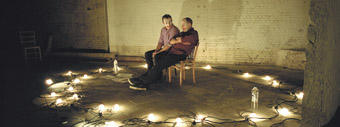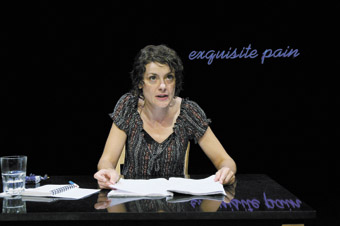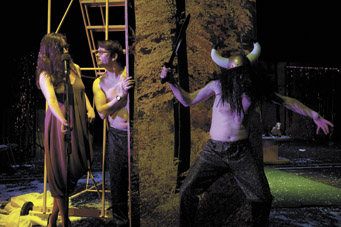radical theatre of failure
christine evans on forced entertainment in vancouver & dublin

Forced Entertainment, Quizoola!
photo Hugo Glendinning
Forced Entertainment, Quizoola!
FORCED ENTERTAINMENT BEGAN IN SHEFFIELD, ENGLAND IN 1984 AND HAVE WORKED TOGETHER SINCE, BUILDING A BODY OF MORE THAN 50 SHOWS. THERE ARE DURATIONAL AND RULE-BASED PERFORMANCES; LARGE AND CHAOTIC THEATRICAL PERFORMANCES; SITE-SPECIFIC WORK; AND “FICTIONAL DOCUMENTARY” SUCH AS NIGHTS IN THIS CITY, A GUIDED BUS TOUR OF SHEFFIELD WHICH MIXES PERSONAL STORY, WORLD EVENTS AND ‘FACTS’ ABOUT OTHER CITIES. THEIR WORK IS “POSTDRAMATIC” IN THE SENSE HANS-THIES LEHMANN ELABORATES IN HIS BOOK OF THE SAME TITLE: IT “PROBLEMATISES ITS STATUS OF ILLUSORY REALITY”. THE FOURTH WALL ISN’T THERE—OR WHEN IT IS, IT’S TORN AND DIRTY, CONSTANTLY FALLING APART INTO REAL TIME.
Forced Entertainment shows take place in the shared space-time of both audiences and performers, and as such implicate the audience in the fiction-making machine of the theatre. There are certainly stories, fictions, dramatic tensions within these performances, but they tend towards the fragment, competing and colliding with other elements of the show rather than forming an overriding architecture. These performances are “shows” rather than “dramas” and as such, both cite and evoke popular performance forms and games.
quizoola
Forced Entertainment’s Quizoola! opened the 2007 PuSh International Performing Arts Festival in Vancouver festival at Ocean Cement—a large workshop space on a wharf that clearly still had a day-life. Entering a still-working space during its downtime to attend an arts show—the life-form superseding heavy industry on the island—was a little eerie, as if the past was dreaming its own future death. And yet the ‘art’ event (Quizoola!) also felt makeshift, industrial; showing its own bones. Metal fold-out chairs were arranged in rows; the performance area was delineated solely by a string of bare light bulbs laid on the floor. Two performers in ordinary clothes and smeared clown make-up were onstage; one was asking the other questions. A third sat on the door, reading and selling tickets. The space evoked cheap theatricality, grease paint and (uneasily, for us in 2007) an interrogation room.
Quizoola! is one of Forced Entertainment’s “durational performances”, lasting six hours. The three performers rotate roles; the audience is free to come and go. The interrogator reads and then riffs from a pile of 2,000 questions compiled by writer-director Tim Etchells and held in a messy sheaf by the questioner. When I walked in, long-time company member Cathy Naden was interrogating Kent Beeson, a local performer who joined the company for Quizoola!, Cathy asks Kent if he can count (Yes); Can he count really, really well? (Yes); How many people in the room? (103); How many men and how many women? (More men than women), I SAID How Many Men And… (Um, 52 women, 51 men); and on and on, until Kent has to calculate impossible mathematics (the number of cars driving by times the number of people wearing glasses divided by…). It’s a game; of course Kent fails, and it’s funny. Many of Forced Entertainment’s shows are based on rule-structures or games. This imposes a different dramaturgy than the arc of dramatic fiction and contains a lot of real-time tension, because things can always go wrong. The rules can be broken. Performers can fail at the “game.” The rules can shift and suddenly include the audience.
And yet it isn’t only funny. The sheer length of the event begins to reveal other rhythms, other temperatures. There’s a cooled-down space of durational performance which escapes the dramaturgy of beginning, middle and end. And in a different way, it’s fascinating—waiting to see what develops. There’s a set list of questions, but when the performers sense a groove, a line of questioning, they follow it. And always there’s the tantalizing possibility that we might be hearing home truths (“When did you cheat on your lover?”). Strangely, personal questions to do with sex are less charged here in 2007 than questions about war and television; people sat still and listened differently during the following sequence:
Did the Gulf War really happen? Yes. How do you know? I saw it on TV. Why does that make it true? Because I saw it on more than one channel. So? If something’s only on one channel, it’s probably made up. If it’s on two channels at the same time, it’s true.
Hours pass. I leave, have dinner, return. The interrogation continues. Paradoxically, a performance relentlessly dedicated to “truth” starts to produce a vision of the world that is utterly phantasmic and internally inconsistent. How to cook lasagna and what a tree is; what’s the history of the world; why milkbottle tops are made of metal; what caused the Balkan wars; and whether you cheated on your lover—all appear together like a mad live newspaper. Slowly, through these questions, the ghost-outline of everyday knowledge rises to the surface of daily life like some fabulous Elizabethan shipwreck. And, watching the actors struggle to survive this shipwreck (that is, the inconsistent knowledges that make up daily life) I’m reminded of Bob Dylan’s line: “All the truth in the world adds up to one big lie.”

Forced Entertainment, Exquisite Pain
photo Hugo Glendinning
Forced Entertainment, Exquisite Pain
exquisite pain
Exquisite Pain was staged the following evening at Performance Works, a lovely intimate black box theatre, a hundred metres down from Ocean Cement. It’s based on artist Sophie Calle’s exhibition and book of the same name; the text and projected images are both taken verbatim from her book. It’s the first time Forced Entertainment has used another writer’s text. The company has recently moved towards these more intimate kinds of performance, involving direct address and a lack of theatrical effect.
Again, the set is bare: tables and chairs, bottles of water, glasses and unbound scripts. Above each table, a flat-screen video monitor. On the black upstage backdrop, in blue neon-sign cursive writing, the show’s title. Cathy and Robin walk out in everyday clothes (jeans, shirts). Robin tells us that Sophie Calle was to meet a lover in New Delhi; on the night of his expected arrival he broke up with her over the phone. Calle decided to tell this story to friends, acquaintances, and strangers for as long as it took for the story to lose its pain for her, and to ask each of them in turn for the story of their greatest suffering.
This simple process of exchange structures the show. Cathy tells the above story in some detail with the projected image of a red telephone in a shabby hotel room as background. Robin then reads his first story, one of the many demanded by Calle of others. Above him, an image of a white basin; the story is of a lover’s betrayal. We switch back to Cathy. She tells the same story as her first one, with almost identical phrasing and the same image. Then a different story from Robin, an image of a blue car. When we switch back to Cathy and there’s another minute variation and the same red telephone appears, there are ripples in the audience. We will be listening, then, to this story for the next two hours, counterpointed with the tales of strangers. Cathy begins each time, like Scheherezade, with a changing count of days: “Five days ago, the man I love left me….” “Twelve days ago, the man I love left me.”
From dread of impending boredom I move to a cool interest and then to fascination. Again, the effect is cumulative; Calle’s narrative/Cathy’s narration is not just moving its internal deckchairs, but in fact shifting, becoming less shock-laden, more wry. Pain is moving through narration into the kind of framing distance that might become, in time, an ironic anecdote. As with Scheherezade, storytelling and death seem to be the two sides of this flowing Mobius strip of narration, a process that—to paraphrase writer/director Tim Etchells—can’t declare itself either comedy or tragedy because in each is the seed of the other. Somewhere towards the end, as Cathy tells the story for perhaps the 50th time, she declares: “As suffering goes, nothing special. Nothing worth harping on about.” (We—the audience laugh. A lot. ) At 98 days she declares, “Enough.”
This show doesn’t produce empathy so much as a kind of cross-infection of experience. Even now I can summon that red telephone. Every detail of that photograph, and the room around it, glows as if it were my own memory etched in pain. And in a sense, of course, it is; these stories invite us to revisit our own.

Forced Entertainment, The World in Pictures
photo Hugo Glendinning
Forced Entertainment, The World in Pictures
the world in pictures
While Quizoola! and Exquisite Pain incline towards to the rule-based, durational strand, The World In Pictures, which I saw two weeks later in Dublin, is theatrical with a vengeance. Fake snow, rampaging cavemen, multiple stage-deaths, group dance numbers, skeleton costumes—it’s all here, in chaotic surges of stage action interspersed with quiet, story-telling. It was a bit of a shock after first encountering the company through their less “theatrical” works.
The show loosely collides two strands—one is the History of the World, which the company attempts to act out in the manner of an amateur children’s pantomime complete with bad wigs, caveman outfits and ridiculous togas, while a Narrator struggles to remember what seems like English school book history. The other strand is a series of stories—low key, everyday—told by Jerry, who addresses us from his everyday persona and clothes. The set is again bare, at least to begin with (“that’s a real fuck-you set”, said someone behind me in the audience), and the cast comes out in everyday clothes. Jerry stands nervously to one side while the others give him acting advice in a sendup of the earnest Method-acting workshop. “Watch those hands in your pockets”, says one. “Just be yourself”, says another. “Try to keep it upbeat.” Then they leave him to it.
“You’re walking through the city with an hour to kill,” Jerry says. His story wanders through a city and takes its walker into a large public-housing tower. “‘You’ climb the stairs, and from the top, imagine what it might be like to fall…you slide over the edge…the ground rushes towards you…excitement, terror, regret…the cars are really close, the cracks in the pavement…I might pause here,” says Jerry, “this has got us into a good place to start the show.”
And with that, the actors charge on to perform a comical fake modern dance to Cecil B de Mille’s apocalyptic movie music (“the volcano scene” from The Last Day of Pompeii). The Narrator puts us through the Greeks, the Romans, the Black Plague, Knightly Love (much cavorting, fake snow, death, and some amusing anachronisms—cavemen masturbating to images on a laptop). “Stuff was happening in Bulgaria. Stuff was happening in Brazil. But here in Europe it was the Dark Ages.” I quite enjoyed the Dark Ages after all the chaos. The performers wander around slowly while the Narrator explains (I’m paraphrasing here), “They forgot everything. They forgot reading. And astronomy, and medicine. And painting. They forgot about government and how to read the time from the position of the stars. They forgot about Literature and the Greeks.”
Being the Dark Ages, the Narrator turns the stage lights off, while Jerry clicks through slides on a laptop and comments on them. Cling-wrapped meat in a butcher’s window. (Something you might have eaten). People on the street. (Someone you might have met). An empty hotel lobby with the furniture stacked in one corner. (Somewhere you might have been). A chair. (A chair). A café. (Somewhere you might have had coffee). A bunch of keys on a table. (Puzzled pause—I don’t remember). A milk bottle. (A milk bottle). A purse (I don’t remember).
The slow superimposition of personal memory onto a different fictitious space, that of History, slides them together into time’s ruins. We’re nearly in the present. The overarching umbrella of history is falling apart, confronted by the here and now. The Narrator loses her confident tone; there are stage-whispers of advice about what to include, what to leave out. She’s uncertain about the 1990s because (looking anxiously at us) “they’ve lived through that.” They decide they’re pretty much done, and leave the coda to Jerry—once again advising him to “keep it positive.”
In his final story, we don’t revisit the spectre of our death from falling—at least, not directly. Imagine (I remember him saying) that soon you’ll be leaving here. And how much of the show will you remember, do you think, in one week? Or in a month? And perhaps, in a year, you won’t remember much of it at all. And the other people here. In two years perhaps someone who’s here tonight might have died. And then, in five years, maybe a few more. Think ahead now…to five hundred years. Will anyone remember you at all?…Well. It’s been a lovely evening.
I loved the weave of personal time and history with the impossibly fictional History of the World. There were many funny and poignant moments, yet I felt being ‘about’ something hampered this show. In contexts where meaning develops associatively through the juxtaposition of many elements (Forced Entertainment’s Bloody Mess and Hidden J), silly theatrics and demonstrative acting can be very effective as one strand in a complex, world-building weave. Here they seemed corralled back into their traditional function in ‘bad’ theatre—illustrating a theme. Since postmodernism has already demolished the omniscient narrator, this aspect of the show seemed like a slightly patronising demonstration of something well established.
And yet Forced Entertainment’s signature elements—the threadbare theatricality that reveals its own means of production, the witty juxtaposition of unlike elements, the promise of stories that never quite deliver what they promise—meant that the show also lived on for me. This is one of the company’s most singular effects. In the hectic failure to stage what they promise (always a part of the comedy), their shows nevertheless weave personal and public spaces together into a kind of poetics of everyday life; everything looks different afterwards. Walking through Dublin for days after The World In Pictures, I was at once in Jerry’s story and my own—a folded fictional space imagined and material.
Forced Entertainment: Robin Arthur, Tim Etchells (artistic director), Richard Lowdon (designer), Claire Marshall, Cathy Naden and Terry O’Connor
Quizoola!, director Tim Etchells, performers Cathy Naden, Robin Arthur, Kent M Beeson; PuSh Festival, Ocean Cement Repair Shop, Ocean Construction, January 10; Exquisite Pain, director Tim Etchells, text and images Sophie Calle, performers Cathy Naden, Robin Arthur, design Richard Lowdon, lighting design Nigel Edwards; PuSh Festival, Performance Works, Vancouver, Feb 11-13; Forced Entertainment, The World In Pictures, direction Tim Etchells, text Etchells and company, performers Robin Arthur, Davis Freeman, Wendy Houstoun, Jerry Killick, Richard Lowdon, Claire Marshall, Terry O’Connor, Bruno Roubicek, design Richard Lowdon, lighting design, Nigel Edwards, soundtrack Found Sources; Project Arts Center, Dublin, Jan 19, 20
RealTime issue #78 April-May 2007 pg. 2,3






